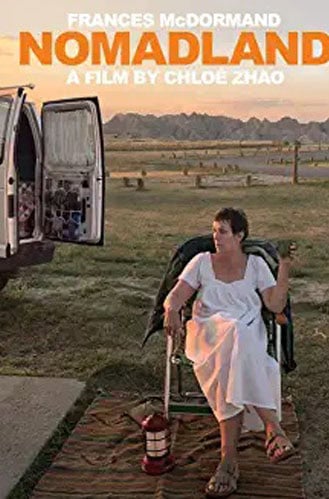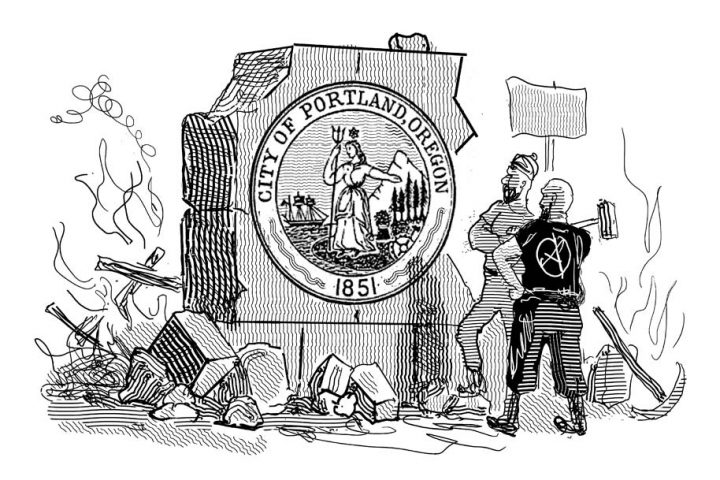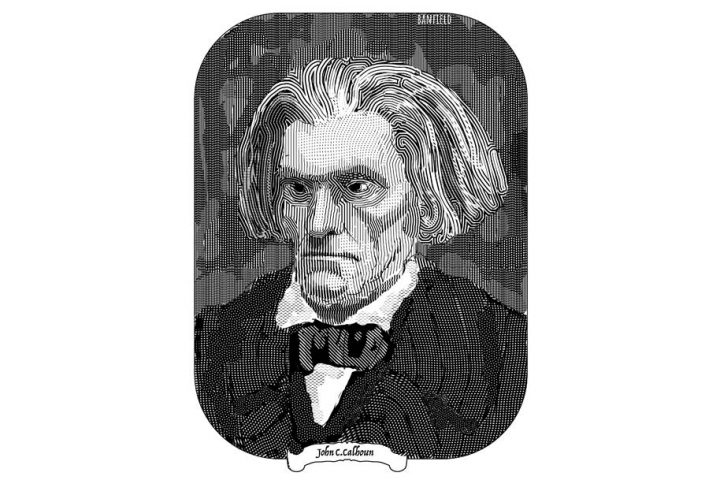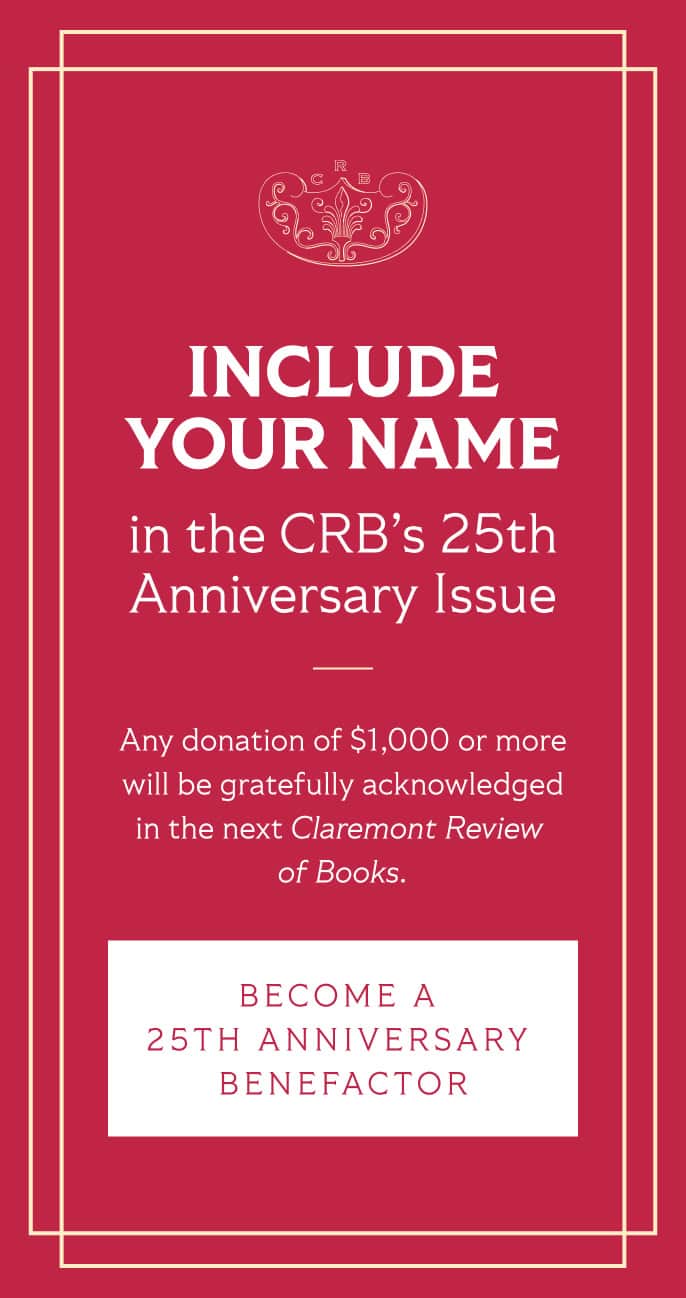Discussed in this Essay
How many Americans live in converted vehicles? More precisely, how many belong to the distinctive “van-dwelling” demographic portrayed in Nomadland, which took home six Oscars earlier this year, including Best Picture, Best Director, Best Actress, and Best Adapted Screenplay? In the eponymous book that inspired the film, journalist Jessica Bruder explains: “Full-time travelers are a demographer’s nightmare. Statistically they blend in with the rest of the population, since the law requires them to maintain fixed—in other words, fake—addresses.” A fair point, but these “nomads” are hardly a cross-section of the population. The vast majority are white, over the age of 60, and unable to retire because they lack sufficient savings, Social Security, or family support to stop working.
Not that they want to retire. “I like work!” says Fern, the film’s main character, played by Frances McDormand. She is speaking to an employment counselor who has just informed her, with bland bureaucratic condescension, that there are no jobs available in the town where Fern has lived and worked for many years. Fern is a fictional character, but her experience is based on that of the nomads in Bruder’s book, several of whom play themselves in this poignant semi-documentary film directed by Hollywood newcomer Chloé Zhao.
Many of these people lost their homes to foreclosure during the 2009 financial crisis. Others lost their jobs when local industries shut down or moved overseas. Still others lost a beloved spouse or child. All found themselves unmoored and, in an effort to make a virtue of necessity, downsized themselves right out of the American Dream.
Fern Joins the Tribe—and the Precariat
Fern’s story begins in the tiny hamlet of Empire, Nevada, a real place that between 1948 and 2011 was wholly owned by United States Gypsum (USG)—a real company that makes drywall, joint compound, and other construction materials. Due to plummeting demand, USG closed its Empire plant in 2011. And because Empire was an old-fashioned “company town,” its residents were evicted and its zip code erased, until May 2016 when it was bought by a new owner, the Empire Mining Company. Today there are rumors of revival, but for the former residents it is surely too late.
Bruder covered Empire’s demise for Harper’s. So when Zhao needed a fictional protagonist for the film, she and Bruder created Fern, a woman in her sixties who leaves Empire after the shutdown. When Fern first appears in the opening scene, she is triply bereft. Her beloved husband, Beau, has died of cancer; her job has disappeared; her community is emptying out. It is a bitterly cold day in the windswept shrub desert of northwest Nevada, and Fern is retrieving a few treasured items from a storage facility to take with her on her journey. As she drives away through the vast, treeless, snow-frosted landscape, her small white van looks achingly alone.
After many hours on the road, Fern checks into an RV park with a special reservation under the name Amazon CamperForce. After spending the night in her van, which in true nomad fashion has been converted into a cramped but efficient living unit, she starts work as a holiday-season temp in an Amazon Fulfillment Center. The film provides few details of the work itself, but Bruder, whose research included a stint as an Amazon “workamper,” provides more:
The workers’ shifts last ten hours or longer, during which some walk more than fifteen miles on concrete floors, stooping, squatting, reaching, and climbing stairs as they scan, sort, and box merchandise…, all the while traversing a warehouse roughly the size of thirteen football fields. The place was so immense that workers used the names of states to navigate its vast interior, calling the western half “Nevada” and the eastern half “Utah”…. [Some of the] more strenuous positions [included] pickers, collecting orders. The year before, one picker had worn a Fitbit to work…. On a single day it logged eighteen miles and forty-four flights of stairs.
Even without these details, Fern’s situation looks grim until she is taken in hand by Linda May, a salt-of-the-earth nomad who introduces her to the van-dwelling “tribe.” A non-actor now in her seventies, Linda May befriended Bruder back in 2014, when she was just beginning to interview nomads. Here Linda May befriends Fern, and to their credit, the filmmakers encourage her to steal every scene. The same is true of Charlene Swankie, another real-life septuagenarian who takes the film to a level not attempted by the book.
A good friend of mine who studies social media recently opined that digital immigrants (people who came of age before the internet) are actually better at using social media than digital natives (people who have never known anything else). This jibes with Nomadland’s admiring portrait of a rugged lifestyle that, while facilitated by social media, could not exist without an array of mechanical, logistical, and interpersonal skills that are more difficult to acquire for a generation whose formative years are spent in the mediated cosmos of the smartphone.
If this geriatric-peripatetic tribe has a chief, it is Bob Wells, a seasoned van-dweller whose online persona is that of an affable Santa who has disencumbered himself from elves, flying sleigh, and reindeer, and adopted a way of life that guarantees not just the pursuit of happiness but its attainment. I have no reason to doubt Wells’s sincerity. To judge by the tributes posted on his YouTube channel (said to have at least 523,000 subscribers), he is dedicated to helping hard-working but hard-up individuals preserve their independence and self-respect. This is more than can be said for most of us.
Wells’s rhetoric echoes the 1960s counterculture in its rejection of middle-class materialism in favor of a pared-down, close-to-nature, vagabond lifestyle. But the dream of free, unfettered wandering began long before Ken Kesey revved up the Magic Bus. It is a universal human impulse, reinforced in America by the restless geographical mobility that has marked this society from Day One. Its most powerful expression is still Walt Whitman’s intoxicating long poem “Song of the Open Road”:
From this hour I ordain myself loos’d of limits and imaginary lines,
Going where I list, my own master, total and absolute….
Gently, but with undeniable will, divesting myself of the holds that would hold me.
I inhale great draughts of space,
The east and the west are mine, and the north and the south are mine.
A perennial theme in American art, literature, and song, love of the open road is also, it must be said, a staple of corporate advertising. For example, have you ever seen an ad for a sleek, sexy car that shows the latest model stuck in traffic?
But advertising is just the beginning. Bob Wells would be loath to admit it, but his rosy vision of van-dwelling makes it easier for Big Tech companies and other titans of globalized capitalism to exploit the cheap labor of a 21st-century “precariat” (precarious proletariat) that includes not just Fern and her silver-haired peers, but legions of college grads willing to go where the gigs are but unable to pay the rent when they get there. In Silicon Valley the cost of housing is now so steep it is common for short-term programmers and engineers to sleep in their parked vehicles while working on lavish corporate campuses that provide them with all the amenities—except, of course, health benefits and job security.
To all but the most cosseted among us, it is clear that these two groups, the resourceful old and the tech-adept young, do not constitute the entire precariat. They are just the groups best able to cope without the supports that, half a century ago, allowed working people to own homes, live in communities, raise families, and in general take responsibility for something larger than their nomadic-monadic selves. In the words of sociologist Ben Snyder, most members of the precariat have to contort their lives (and the lives of their families, if they have them) in order to fit the mold of “a worker who, on any given day, can deliver a precise and context-specific amount of labor power according to employers’ needs and then be easily tossed aside.”
Seeking a “Sublime Old Age”
How does Nomadland deal with this large and politically charged backdrop? It depends on whether we are talking about the book or the film. The book is quite hard-hitting about the economic circumstances that cause so many elderly Americans to become nomads. But it says very little about the impact of those same circumstances on the millions of ordinary Americans who do not wish to bring up their children in vehicles. And despite her genuine empathy with the people she profiles, Bruder does not make it her business to plumb the depths of their souls. It is not that kind of book.
It is that kind of film, however. Zhao is the daughter of a prominent Beijing businessman and stepdaughter of a celebrated film and TV actress. Like many well-heeled Chinese of her generation, she left home early, attending boarding school in London, high school in Los Angeles, college at Mount Holyoke, and film school in New York. Without knowing much more than that, I am tempted to seek a connection between Zhao’s personal history and the intense focus, in her first two films, on the tension between wanderlust and the pull of home and family.
Zhao’s first film, Songs My Brothers Taught Me (2015), is about Johnny, an Oglala Sioux teenager whose attachment to his family is frayed by his father’s womanizing, which has resulted in a slew of half-brothers and half-sisters on the Pine Ridge Reservation where they live. Johnny’s mother tries to care for him and his sister but struggles with alcoholism and a series of bad relationships. Johnny’s desire to escape is potent, and when his college-bound girlfriend asks him to accompany her to Los Angeles, he is tempted. But in the end, he cannot bring himself to break the strongest bond in his life, which is with his younger sister, a remarkable child who nonetheless needs his help to avoid the traps and snares set for young women “on the Rez.”
The second film, The Rider (2017), is about Brady, another Oglala Sioux teenager whose rodeo career is cut short when a horse kicks him in the head, seriously fracturing his skull. The doctors say he will never ride again, but he refuses to believe it. Brady, too, has a sister: a mentally disabled girl who understands her brother better than anyone. He also has a friend, a champion bull-rider, who is paralyzed after a nasty fall. All of this gives Brady plenty to brood about, and there are several long close-ups of him doing just that. Finally, he vows to return to the rodeo and ride the same horse, even if it kills him. But then, in a subtle shift worthy of Zhao’s cinematic hero, Terrence Malick, he sees his sister and father standing on the sidelines and, turning his back on the raging horse in the chute, walks over to join them.
Zhao’s next film, made before Nomadland but not scheduled for release until November of this year, is Eternals, the latest mega-bucks addition to the ever-expanding Marvel Cinematic Universe. The only connection I can discern between Eternals and Zhao’s other films is the practical one of cross-funding. Let us hope the success of Nomadland will save her from having to ride the MCU bull again.
I say this because what Zhao has done with Nomadland is raise a timely, informative, but pedestrian work of journalism to the level of luminous art. She has done this not by denying the reality described in the book, but by greatly enlarging its scope, so that it touches a far more intimidating reality that all human beings must eventually face: old age and death. The key to this transformation is the way this film resolves the same tension found in her first two films, between wanderlust and the pull of home and family.
Unlike her fellow nomads, Fern receives not one but two invitations to quit the road and settle into a loving and comfortable home. The first comes from her sister, who yearns to reconcile past differences. The second comes from a fellow nomad, David (David Strathairn), who upon the urging of his son (and Fern) agrees to “go home and be a grandfather.” David is sweet on Fern and shyly offers her the guest house adjoining his son’s beautiful, spacious house overlooking the Pacific Ocean.
Not many nomads get invitations like this, and the first time I watched the film, I found it slightly perverse that Fern would rebuff them both. Neither Johnny nor Brady would dream of doing that.
But when I watched Nomadland a second time, paying closer attention to McDormand’s beautifully understated performance, underscored by Ludovico Einaudi’s beautifully understated music, I understood why Fern chooses wanderlust. She is not rejecting human connection; she is trying to loosen it, in order to ease the pain of its final rupture. Mostly, she is following in the path of her friend Swankie, who has terminal cancer and is determined to meet her end with a sense of awe rather than fear. Here again, it is Whitman who said it best:
Journeyers with their own sublime old age of manhood or womanhood,
Old age, calm, expanded, broad with the haughty breadth of the universe,
Old age, flowing free with the delicious near-by freedom of death.








